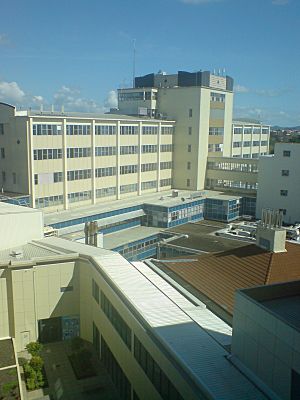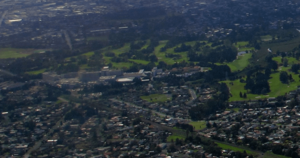Middlemore Hospital facts for kids
Quick facts for kids Middlemore Hospital |
|
|---|---|
| Counties Manukau Health | |
 |
|
| Geography | |
| Location | Ōtāhuhu, Auckland, New Zealand |
| Organisation | |
| Care system | Public Hospital |
| Hospital type | Tertiary hospital |
| Affiliated university | University of Auckland |
| Services | |
| Emergency department | Yes |
| Beds | 980 beds |
| History | |
| Founded | 1947 |
Middlemore Hospital is a large public hospital located in Ōtāhuhu, Auckland, New Zealand. It has around 800 beds and 24 operating rooms across two main areas. It is a very busy hospital that helps many people in the Auckland region every year.
Contents
Hospital History
In 1943, during World War II, work began on a hospital with 300 beds in Ōtāhuhu. It was first built to help sick and injured soldiers from the war. It was known as the Otahuhu Military Hospital. By 1945, the war had ended, so the hospital was no longer needed for soldiers. Instead, it became a hospital for everyone.
In 1944, it was decided the hospital would be called Middlemore Hospital. This name came from the Thompson family farm, which was close to where the hospital was built. The hospital officially opened its doors on May 3, 1947.
Middlemore Hospital is one of the biggest hospitals in Auckland. It has about 4,700 staff members. They help over 91,000 patients who stay overnight and more than 354,000 patients who visit for appointments each year. The Emergency Department (ED) at Middlemore is one of the busiest in Australia and New Zealand. It sees almost 100,000 patients every year. The hospital also helps many expecting mothers, with over 20 babies born there each day.
How the Hospital Works
Middlemore Hospital is run by Counties Manukau Health. It provides special hospital care and other health services for people in the Counties Manukau area. This area stretches from Ōtāhuhu to Port Waikato and has over 525,000 people. This population is growing quickly, so the hospital plans to expand to help even more patients in the future.
The hospital also has other places where patients can stay or get help. These include:
- Kidz First Children's Hospital
- Manukau Surgery Centre
- Pukekohe Hospital
- Franklin Memorial Hospital
- Botany Downs Maternity Unit
- Papakura Maternity Unit
Middlemore Hospital offers many special medical services. These include:
- General surgery (common operations)
- Orthopaedic surgery (bone and joint operations)
- Plastic surgery (reconstructive surgery)
- Dentistry (teeth care)
- Kidney dialysis (for kidney problems)
- Neonatal intensive care (for very sick newborns)
New Hospital Buildings
Harley Gray Building
A new five-story building, called the Harley Gray Building, opened in April 2014. It cost about NZ$190 million. This building has:
- 14 new operating rooms
- A special unit for 38 newborn babies needing care
- A unit with 42 beds for patients needing quick medical checks
- Areas for patients to get ready for surgery and recover afterwards
- A modern area for cleaning medical tools
The building was named after Harley Gray, who was an orthopaedic surgeon at Middlemore until 2001.
Ko Awatea Centre
The Ko Awatea Centre was built in 2011. It cost NZ$10 million. This centre helps the hospital find new and better ways to provide healthcare. It is a place for education, improvement, and new ideas. It supports the staff at Counties Manukau Health and also works with other health groups in New Zealand and around the world. The name "Ko Awatea" means 'first light' in Māori.
Edmund Hillary Block
The Edmund Hillary Block is a six-story building for patients that opened in 2009. It added 240 new beds and a lot more space to the hospital. It includes:
- Wards for mental health services for older people
- Wards for plastic surgery patients
- Wards for general surgery and medical patients
- A unit for heart investigations
- Offices for health staff and a gym
- A new cafeteria for staff
Intensive Care Unit
In June 2008, a new intensive care unit (ICU) was opened. It cost NZ$6.4 million and was considered one of New Zealand's most advanced. This unit has 18 beds, which is much more than the previous 7 beds. It can treat about 1,000 patients each year who need very serious care. The unit also has special rooms for patients with infections.
National Burn Centre
In June 2006, the hospital opened a new special ward for treating burns, called the National Burn Centre. This facility cost NZ$7.2 million to build and equip. It is the main place in New Zealand for treating patients with very serious burns from all over the country. It also helps about 400 local burn cases each year.
Other Hospital Facilities
Manukau Surgery Centre
The Manukau Surgery Centre provides day surgery and planned operations. It is for patients who do not need very intensive care. The centre has 10 operating rooms, 2 procedure rooms, and 78 beds for patients. Many types of surgery are done here, including:
- Orthopaedic surgery (like joint replacements)
- General surgery
- Plastic surgery
- Eye surgery
Manukau SuperClinic
The Manukau SuperClinic (MSC) is where patients go for special outpatient appointments and day procedures. It has different sections for various medical needs, such as:
- Orthopaedics (bones and joints)
- Ear, Nose, and Throat (ENT)
- Paediatric Medicine (children's health)
- Plastic and Hand Surgery
- Eye care
- Neurology (brain and nerves)
- Women's Health
Kidz First Children's Hospital
The Kidz First Children's Hospital is specially built to provide family-focused healthcare for the diverse community of Counties Manukau. It offers many services for children, including:
- Surgical care for children (like orthopaedic and plastic surgery)
- Medical care for children
- A child protection service that helps with child safety issues
South Auckland Clinical Campus
The South Auckland Clinical Campus (SACC) is located at Middlemore Hospital. It is part of The University of Auckland's Faculty of Medical and Health Sciences. This campus helps teach medical students and does research in partnership with Counties Manukau Health. They have research groups focusing on areas like surgery, women's health, and plastic surgery.


